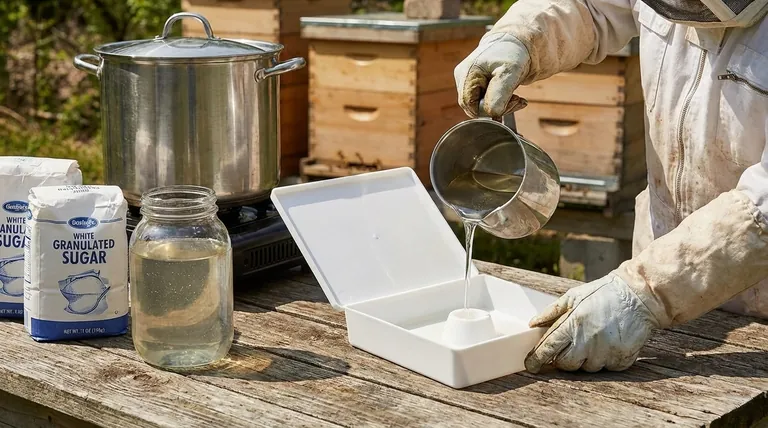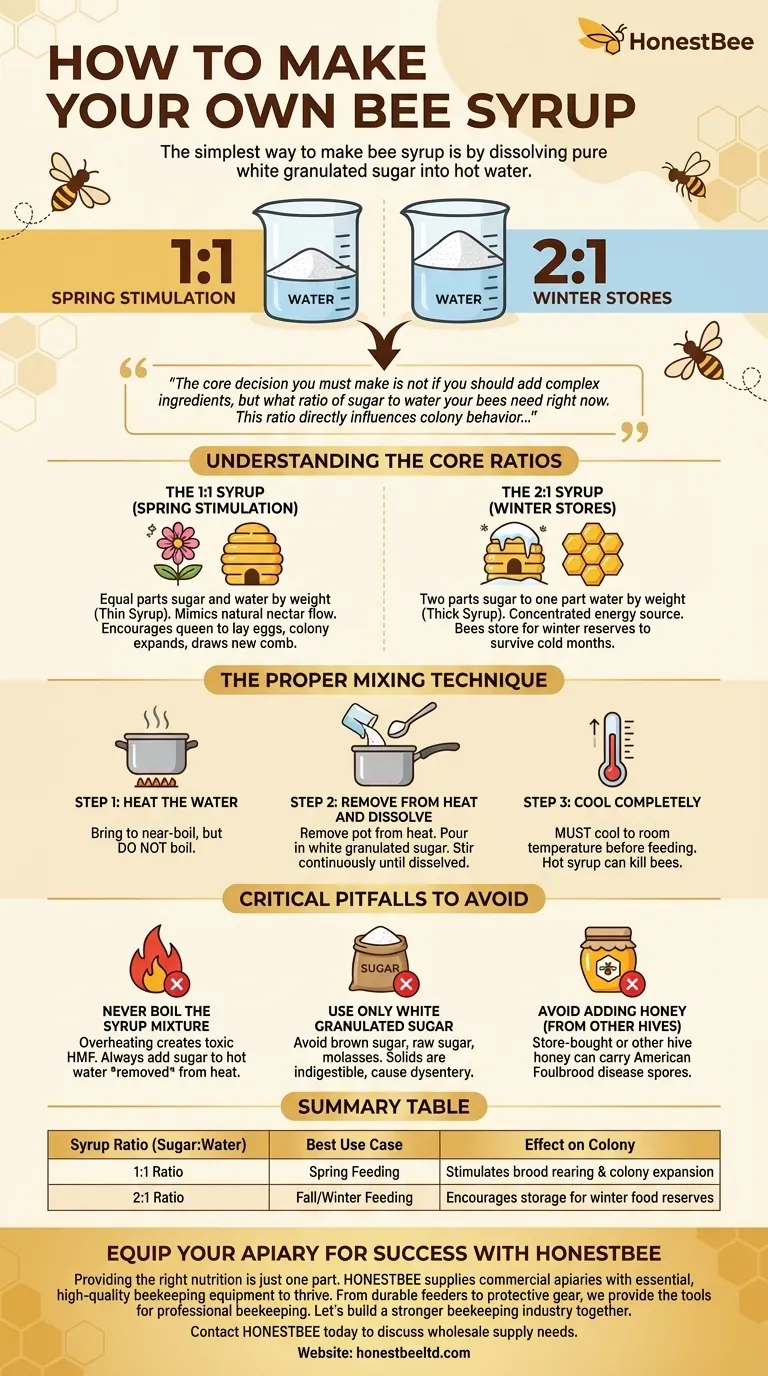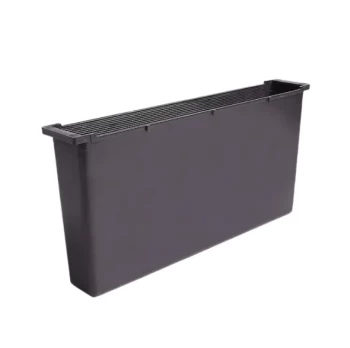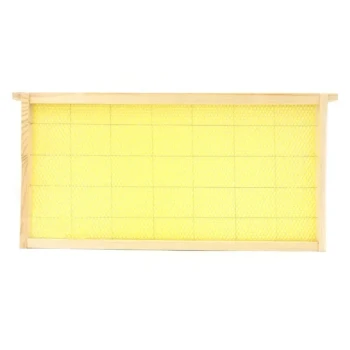The simplest way to make bee syrup is by dissolving pure white granulated sugar into hot water. The most common recipes are a 1:1 ratio of sugar to water by weight for spring feeding and a 2:1 ratio for fall feeding. It is critical that you do not boil the mixture and that you allow it to cool completely to room temperature before offering it to your bees.
The core decision you must make is not if you should add complex ingredients, but what ratio of sugar to water your bees need right now. This ratio directly influences colony behavior, determining whether they use the syrup for immediate expansion or for long-term winter storage.

Understanding the Core Ratios
The needs of a honey bee colony change dramatically with the seasons. Your feeding strategy should change as well. The ratio of sugar to water in your syrup sends a specific signal to the bees.
The 1:1 Syrup (Spring Stimulation)
A 1:1 ratio, meaning equal parts sugar and water by weight, creates a thin syrup.
This light consistency mimics the natural nectar flow of spring flowers. Feeding 1:1 syrup encourages the queen to begin laying eggs and stimulates the colony to draw out new comb and expand its population.
The 2:1 Syrup (Winter Stores)
A 2:1 ratio, or two parts sugar to one part water by weight, creates a thick, heavy syrup.
This dense syrup is less about stimulation and more about providing a concentrated energy source. Bees will readily store this in the comb, creating the food reserves they need to survive the cold winter months when foraging is not possible.
The Proper Mixing Technique
The process is simple, but precision is key to ensuring the syrup is safe and effective for your bees.
Step 1: Heat the Water
Begin by heating only the water in a clean pot. Bring it to a near-boil, but do not let it reach a full, rolling boil.
Step 2: Remove from Heat and Dissolve
Once the water is sufficiently hot, remove the pot from the heat source completely.
Immediately pour in the pre-measured white granulated sugar. Stir continuously until every sugar crystal has completely dissolved and the liquid is clear.
Step 3: Cool Completely
This is a non-negotiable step. The syrup must cool to room temperature before it is placed in a feeder. Hot syrup can burn and kill your bees.
Critical Pitfalls to Avoid
Simple mistakes in preparation can have severe consequences for your colony's health. Understanding what not to do is as important as knowing the recipe.
Never Boil the Syrup Mixture
Boiling sugar and water together or overheating the sugar can cause it to caramelize. This process creates Hydroxymethylfurfural (HMF), a compound that is toxic and often fatal to honey bees. Always add sugar to water that has been removed from the heat.
Use Only White Granulated Sugar
Avoid using brown sugar, raw sugar, molasses, or any other unrefined sugars. These contain solids and compounds that bees cannot digest, which can lead to dysentery and weaken the colony. Plain white table sugar is the safest and most effective choice.
Avoid Adding Honey (From Other Hives)
While it may seem natural to add honey, never use store-bought honey or honey from a hive other than your own. Honey can carry spores for devastating diseases, most notably American Foulbrood, which can easily infect and destroy your entire colony.
Making the Right Choice for Your Goal
Select your syrup based on the specific needs of your colony and the time of year.
- If your primary focus is encouraging spring population growth: Use a 1:1 sugar-to-water syrup to simulate a nectar flow and stimulate brood rearing.
- If your primary focus is building winter food stores: Use a 2:1 sugar-to-water syrup to provide a dense, easy-to-store energy source.
- If you are ever in doubt: A simple, unadulterated mixture of pure white sugar and water is always the safest and most reliable choice for your bees.
By providing the correct nutritional support at the right time, you empower your bees to thrive throughout the year.
Summary Table:
| Syrup Ratio (Sugar:Water) | Best Use Case | Effect on Colony |
|---|---|---|
| 1:1 Ratio | Spring Feeding | Stimulates brood rearing & colony expansion |
| 2:1 Ratio | Fall/Winter Feeding | Encourages storage for winter food reserves |
Equip Your Apiary for Success with HONESTBEE
Providing the right nutrition is just one part of a successful beekeeping operation. To maximize the health and productivity of your hives, you need reliable, high-quality equipment.
HONESTBEE supplies commercial apiaries and beekeeping equipment distributors with the essential supplies they need to thrive. From durable feeders and hive tools to protective gear and extraction equipment, we provide the tools for professional beekeeping.
Let's build a stronger beekeeping industry together.
Contact HONESTBEE today to discuss your wholesale supply needs and discover how our products can support your business goals.
Visual Guide

Related Products
- HONESTBEE Professional Hive Top Bee Feeder Feeding Solution
- HONESTBEE Round Hive Top Bee Feeder for Syrup
- HONESTBEE Entrance Bee Feeder Professional Hive Nutrition Solution for Beekeeping
- Rapid Bee Feeder White Plastic 2L Round Top Feeder for 8 or 10-Frame Bee Hives
- Classic Boardman Entrance Bee Feeder Hive Front Feeding Solution
People Also Ask
- How is the plywood floor fitted into the hive-top feeder? Ensure Longevity with a Floating Floor Design
- What features make top feeders a reliable choice for beekeepers? A Guide to Safe, Efficient Hive Nutrition
- What should be done with feeders and equipment after feeding bees? Essential Steps for Apiary Health
- What is the best way to top feed bees? A Safe, High-Volume Feeding Solution for Your Apiary
- How do I keep bees from drowning in my top feeder? Ensure Safe Feeding for Your Hive



















